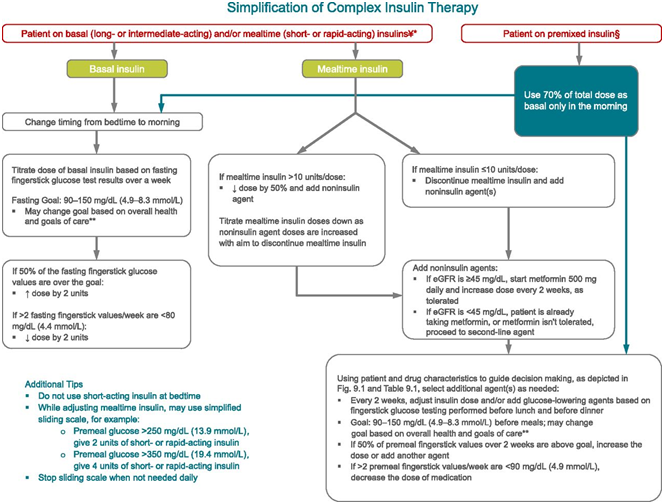Older Adults
The natural history of diabetes in older adults differs from that in younger patients, partly because of shorter life expectancy, increased comorbidity, and a greater risk of treatment-related complications.1
- 50-80% of adults >65 years of age have diabetes or prediabetes.2
- 61% of all expenditures attributed to diabetes are incurred by patients >65 years. 3
- Older adults with diabetes havehigher complication rates than younger cohorts.3
- One-third of all people with diabetes are >65 years.4
Diabetes management strategies for high-functioning older people with long life expectancies are similar to those used in younger patients.1Life expectancy is an important factor in treatment decisions for older patients near the end of life. As morbidity and functional impairment increase, the anticipated benefit of glycemic control declines.2
Algorithm to Simplify Insulin Regimen in Older Adults with T2DM.5

Resources
American Diabetes Association. 12. Older Adults: Standards of Medical Care in Diabetes—2020. Diabetes Care.2020;43(Supplement 1):S152-S162.
References
- Strain WD, et al. Type 2 diabetes mellitus in older people: a brief statement of key principles of modern day management including the assessment of frailty. A national collaborative stakeholder initiative. Diabetic Medicine. 2018;35(7):838-845.
- Halter JB, et al. Diabetes and cardiovascular disease in older adults: current status and future directions. Diabetes. 2014;63(8):2578-2589.
- Leung E, et al. Diabetes management in the elderly. Diabetes Spectrum. 2018;31(3):245-253.
- Schernthaner G, Schernthaner-Reiter MH. Diabetes in the older patient: heterogeneity requires individualisation of therapeutic strategies. Diabetologia. 2018;61(7):1503-1516.
- American Diabetes Association. 12. Older Adults: Standards of Medical Care in Diabetes—2020. Diabetes Care.2020;43(Supplement 1):S152-S162.



